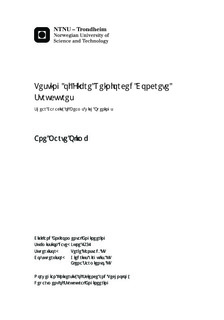| dc.contributor.advisor | Kanstad, Terje | nb_NO |
| dc.contributor.advisor | Zirgulis, Giedrius | nb_NO |
| dc.contributor.advisor | Sarmiento, Elena | nb_NO |
| dc.contributor.author | Olimb, Ane Marte | nb_NO |
| dc.date.accessioned | 2014-12-19T12:00:34Z | |
| dc.date.available | 2014-12-19T12:00:34Z | |
| dc.date.created | 2012-11-08 | nb_NO |
| dc.date.issued | 2012 | nb_NO |
| dc.identifier | 566012 | nb_NO |
| dc.identifier | ntnudaim:7646 | nb_NO |
| dc.identifier.uri | http://hdl.handle.net/11250/236971 | |
| dc.description.abstract | The thesis examines the use of fibre reinforced concrete in carrying structures. The basis of the project is shear capacity of beams with openings which is a very common structural element. It has been carried out full-scale tests of one reference beam and three beams with openings reinforced with different reinforcement combinations.The first part of the report consists of a literature study based on earlier research and published material on fibre reinforced concrete and its use in carrying structures. Different fibres and their properties are described as well as the components in concrete and their effect. As of today there are no official set of rules for designing fibre reinforced structures, but there are several suggestions for rules which are described in the report. The most important set of rules for this project is made by COIN (Concrete Innovation Centre). The calculations done in the project are based on the COIN-report.The concrete used in the tests were delivered by Unicon and the castings were done in two days, one casting with plain concrete (reference beam and one beam with openings with traditional shear reinforcement) and one casting with fibre reinforcement (Dramix 80/60). The fibre reinforced beams with openings consisted of one beam with a combination of fibre and traditional shear reinforcement and one with only fibres as shear reinforcement. The casting of the fibre reinforced concrete proved difficult as the fibres were lumping together and deteriorated the flowability. Therefore the FRC required a lot of work while being cast.In addition to the full-scale beams standard beams and testing cubes were cast. These were later tested to establish the strength properties of the concrete. The tests showed that both the compressive strength and the residual tensile strength were higher than the theoretical values used in the pre-testing calculations, so post-testing calculations were carried out as well.The full-scale beams were tested at the structural laboratory at NTNU. The testing was done in a rig with a four point testing set-up with two symmetrical loads. The beams were instrumented to measure the midspan vertical displacement as well as the crack openings beneath the openings and a computer registered the measured values. Both the fibre reinforced beams proved to have better capacity and ductility than the plain concrete beams. This indicates that steel fibre reinforcement is a good solution for shear reinforcement for beams with openings.Most of the calculations done were in good accordance with the test results although they were a bit on the conservative side. The calculations for the beam with only fibre reinforcement were not very good, and post-testing calculations were done to find the width of a theoretical tensile trajectory based on the real capacity. All in all the tests showed that the use of FRC in beams with openings might be a good solution in the future. More research should be done on this subject to develop design rules for FRC beams with openings. | nb_NO |
| dc.language | eng | nb_NO |
| dc.publisher | Institutt for konstruksjonsteknikk | nb_NO |
| dc.subject | ntnudaim:7646 | no_NO |
| dc.subject | MTBYGG Bygg- og miljøteknikk | no_NO |
| dc.subject | Konstruksjon | no_NO |
| dc.title | Testing of Fibre Reinforced Concrete Structures: Shear Capacity of Beams with Openings | nb_NO |
| dc.type | Master thesis | nb_NO |
| dc.source.pagenumber | 121 | nb_NO |
| dc.contributor.department | Norges teknisk-naturvitenskapelige universitet, Fakultet for ingeniørvitenskap og teknologi, Institutt for konstruksjonsteknikk | nb_NO |

